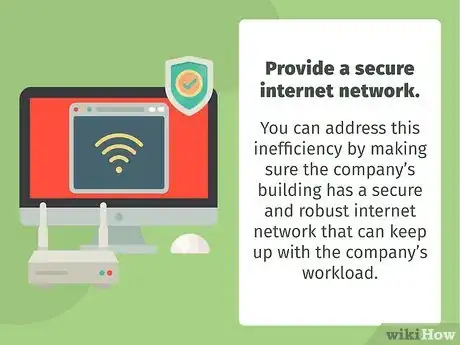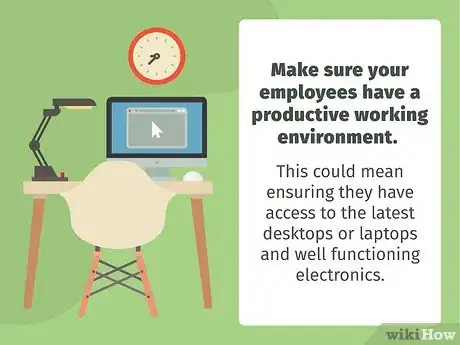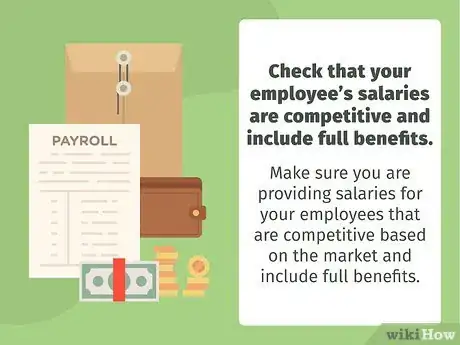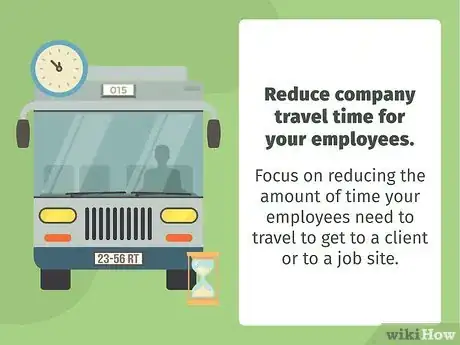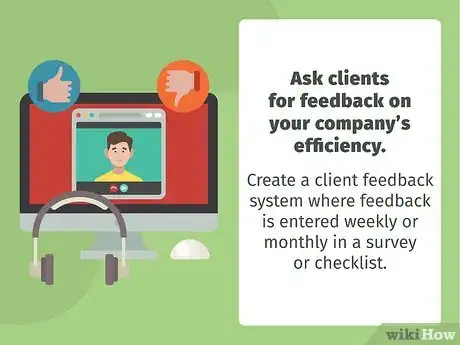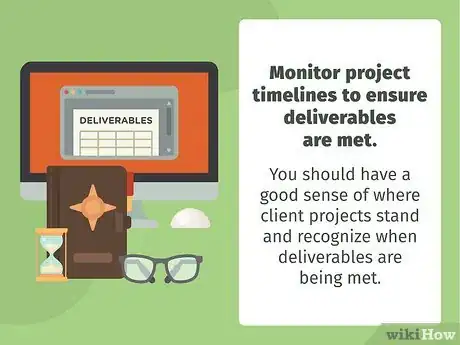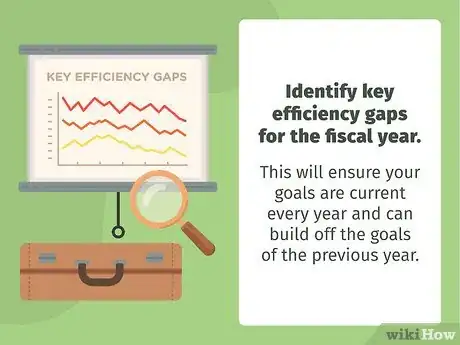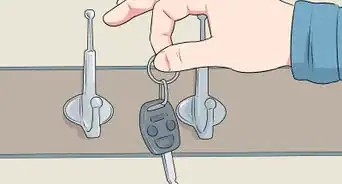This article was co-authored by Dan Bodner. Dan Bodner is a Transitional Shelter & Homelessness Expert and the CEO & Founder of QuickHaven Transitional Shelters. With over 20 years of experience, he specializes in executive leadership, product development, and innovation, which have helped him develop modular tiny homes to improve the lives of those affected by homelessness. Dan earned a BA from Vassar College and an MS from the University of Texas at Austin.
This article has been viewed 101,511 times.
Efficiency strategies are integral parts of any business. With these strategies, you can maximize efficiency and set company objectives and standards for delivering value. This will allow your business to achieve high productivity and manageable costs.[1] You can focus your efficiency strategies in three main areas: improving the efficiency of your employees, improving the company’s efficiency when dealing with clients, and improving the efficiency of the company as a whole.
Steps
Implementing Employee Efficiency
-
1Identify gaps in employee efficiency. Before you can create employee efficiency goals, you need to identify any gaps or issues in employee efficiency at your company. If you have several departments in your company, you may want to try to identify at least one to two efficiency gaps in each department.[2]
- For example, you may have an efficiency gap between employee hours and completed projects. Though your employees seems to be working full workdays, projects are not being completed and profit margins are not being met. You may then analyze how your employees are working. Perhaps they do not have access to the latest technology, leading to slower work processes and a failure to meet project timelines. This may then be one efficiency gap for your employees: a non productive work environment.
- Another example you may notice is that your employees do not seem as motivated or energized in the workplace and as a result, client relationships are suffering and projects are not going as smoothly as they should. You may then identify another efficiency gap: low motivation and incentives for employees.
-
2Provide a secure internet network. Many employee inefficiencies, like miscommunication among employees and clients, poor employee performance, and missed deadlines, can be traced back to a poor internet network. You can address this inefficiency by making sure the company’s building has a secure and robust internet network that can keep up with the company’s workload. [3]
- This is especially important if your employees use the internet to communicate with clients and with each other. A slow or faulty network can lead to missed emails, failed client communication, and delayed feedback from clients, thereby slowing down your employee’s productivity.
-
3Make sure your employees have a quiet and productive working environment. As an employer, it is also essential that you provide a productive working environment for your employees to make sure they are being as efficient as possible. This could mean ensuring they have access to the latest desktops or laptops and well functioning electronics like printers, scanners, and fax machines. You should also make sure there are fully functioning conference phones in each meeting room and provide mobile phones for company use if your employees are often on the go.[4]
- You may want to also make it easier for your employees to share information among each other by using Google Drive or another file sharing program. This way, important documents do not get misplaced or forgotten, allowing your employees to use technology and file sharing in the most efficient way possible.
- Switching to online file sharing will also cut down on the amount of paper waste your company produces every year, thereby eliminating inefficiencies like high waste production and money spent on recycling and reducing waste in the office.
-
4Check that your employee’s salaries are competitive and include full benefits. Another possible cause of employee inefficiency is a lack of competitive compensation. If you are underpaying and overworking your employees, this could lead to resentment, low motivation, and high stress levels among your employees. Make sure you are providing salaries for your employees that are competitive based on the market and include full benefits, such as healthcare and a 401K or another employee retention program.[5]
- Most employees will work harder and better if they know they have job security and stability and can rely on their employer to provide a fair, competitive wage. Healthcare and a retirement plan are also big incentives for employees to work efficiently and can help you keep your employees for a long period of time. This will then reduce the need to spend money on hiring and training for new employees.
-
5Reduce company travel time for your employees. Travel on company time and company expense can lead to reduced operational efficiency and wasted resources. Focus on reducing the amount of time your employees need to travel to get to a client or to a job site. If possible, rely on video conferencing and email as much as possible to reduce the need for employee travel and only allow employee travel when it is absolutely necessary.[6]
-
6Implement an employee recognition program. Make your employees feel they are essential to your company, and necessary for improved efficiency in the company by creating an employee recognition program. Designate a supervisor or lead from each department to choose one employee who represents hard work, diligence, the company culture, and/or operational efficiencies.
- The program could then reward recognized employees with a bonus, a name entered into a draw, or even a shout out of social media. The reward does not need to be expensive or lavish. Rather, it should spotlight the employee and ensure they feel recognized by the company, other employees, and clients.
-
7Create an employee efficiency committee. To keep up to date on employee efficiencies, you could encourage supervisors or leads to form an employee efficiency committee. Try to have a representative from each department or area on the committee so it is well rounded. Schedule monthly meetings to discuss how to improve the employee efficiencies and ensure at least one to two efficiency goals are created each month.
Implementing Client Efficiency
-
1Set up weekly check ins with clients. To improve client efficiency, you can personally check in with your clients, or focus on specific high need clients, and discuss possible inefficiencies or issues. Ask your clients how their overall experience with the company has been, as well as how they feel their project manager, leader, or contact is doing in terms of time management and communication.[7]
- You should also make sure employees are maintaining active communication with their clients and touching base on a daily or weekly basis. Though your employees may have a lot of projects on their plate, it is important that they keep communication with their clients open and accessible. This will show they can efficient with their time and maintain an efficient relationship with clients.
-
2Ask clients for feedback on your company’s efficiency. You should be willing and ready to note any feedback from clients you receive in your weekly check in. Create a client feedback system where feedback is entered weekly or monthly in a survey or checklist. You can then review the feedback with your employees to give them a sense of client expectations and needs.[8]
- You can also use client feedback to identify client inefficiencies, such as missed deadlines or failed communication. You can work with your employees to create possible solutions for these inefficiencies, such as scheduling deadlines one week early to ensure they are met or maintaining daily check ins with clients to keep communication open and accessible.
-
3Monitor project timelines to ensure deliverables are met. While you do not want to micro manage your employees or your clients, you should have a good sense of where client projects stand and recognize when deliverables are being met. This may mean walking the floor of the office several times a day to check in with certain teams or areas or scheduling daily or weekly check in meetings for employees working on certain accounts or projects.[9]
- Try to identify projects where clients are high need or high risk and keep a close eye on these. You may also want to ensure the employees on the account or project are prepared to tackle the needs of the client and can respond well to the client expectations. A big part of setting a project up for success is making sure the employee and the client work well together.
Implementing Company Efficiency
-
1Identify key efficiency gaps for the fiscal year. Take a broad view of company efficiency and try to identify at least four to five efficiency gaps you would like employees to focus on for the fiscal year. This will ensure your goals are current every year and can build off the goals of the previous year.
- You may have company efficiency goals like improving the work environment by switching to a more sophisticated computer program or computing system, reducing the amount of paper waste produced in the office, providing better compensation for long standing employees, and ensuring clients receive more effective project management from employees.
- Once you have identified the key efficiency gaps for the year, assign one goal to each department or area in the company. This will ensure it is clear who is accountable for addressing the gap and increase the likelihood that the gap will be addressed.
-
2Improve the company’s technology every fiscal year. Most companies can improve their efficiency by improving their technology every year, from upgrading to faster computers to investing in several scanners or printers for use in the office. Focusing on the latest technology will keep operational efficiency high and allow your employees to work to their full potential.[10]
- If you have growing IT needs and demands, you may want to consider outsourcing your IT needs to a contractor or outside company. This may be a necessary expense if the company is not able to keep up with the IT needs of clients and employees, and allow your company to focus on providing excellent customer service and meeting deadlines, rather than IT issues.
-
3Update the company’s efficiency needs based on employee and client feedback. Use feedback from your clients and your employees to add to the company’s efficiency goals and make sure these goals are up to date and current. Let your employees and your clients know that they are active participants in implementing efficiency strategies at the company and that you rely on them to help the company become more efficient.[11]
Expert Q&A
-
QuestionHow can productivity and efficiency be improved at work?
 Dan BodnerDan Bodner is a Transitional Shelter & Homelessness Expert and the CEO & Founder of QuickHaven Transitional Shelters. With over 20 years of experience, he specializes in executive leadership, product development, and innovation, which have helped him develop modular tiny homes to improve the lives of those affected by homelessness. Dan earned a BA from Vassar College and an MS from the University of Texas at Austin.
Dan BodnerDan Bodner is a Transitional Shelter & Homelessness Expert and the CEO & Founder of QuickHaven Transitional Shelters. With over 20 years of experience, he specializes in executive leadership, product development, and innovation, which have helped him develop modular tiny homes to improve the lives of those affected by homelessness. Dan earned a BA from Vassar College and an MS from the University of Texas at Austin.
Transitional Shelter & Homelessness Expert Make sure that employees have a space where they can fully focus on their work. For instance, an open office setting doesn't offer any privacy and often forces employees to sit really close to one another.
Make sure that employees have a space where they can fully focus on their work. For instance, an open office setting doesn't offer any privacy and often forces employees to sit really close to one another.
References
- ↑ https://hbr.org/2006/03/how-to-implement-a-new-strategy-without-disrupting-your-organization/ar/1
- ↑ http://www.entrepreneur.com/article/229557
- ↑ http://www.informationweek.com/10-tips-for-increasing-operational-efficiency/d/d-id/1057885?
- ↑ http://www.informationweek.com/10-tips-for-increasing-operational-efficiency/d/d-id/1057885?
- ↑ http://www.informationweek.com/10-tips-for-increasing-operational-efficiency/d/d-id/1057885?
- ↑ http://www.informationweek.com/10-tips-for-increasing-operational-efficiency/d/d-id/1057885?
- ↑ http://www.informationweek.com/10-tips-for-increasing-operational-efficiency/d/d-id/1057885?
- ↑ http://www.bizcoachinfo.com/archives/7517
- ↑ http://www.bizcoachinfo.com/archives/7517
About this article
There are a few main areas you should focus on when implementing efficiency strategies. The first is employee efficiency. Make sure your employees have a productive work environment, are rewarded and recognized for being efficient, and enjoy a competitive salary so they're more motivated. The second area you should focus on is client efficiency. Remember to check in with clients every week, ask them for feedback on your efficiency, and monitor project timelines closely. The final area you should focus on is company efficiency. Make sure you're improving your company's technology every fiscal year, identifying key efficiency gaps, and updating your efficiency needs regularly based on client and employee feedback. For advice on how to address efficiency gaps within your company, keep reading!

